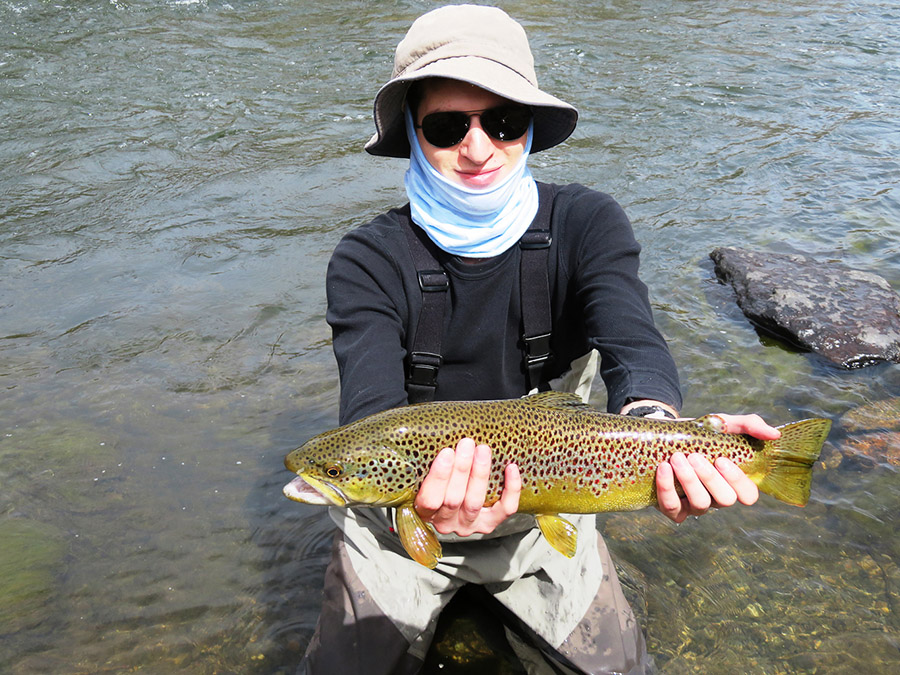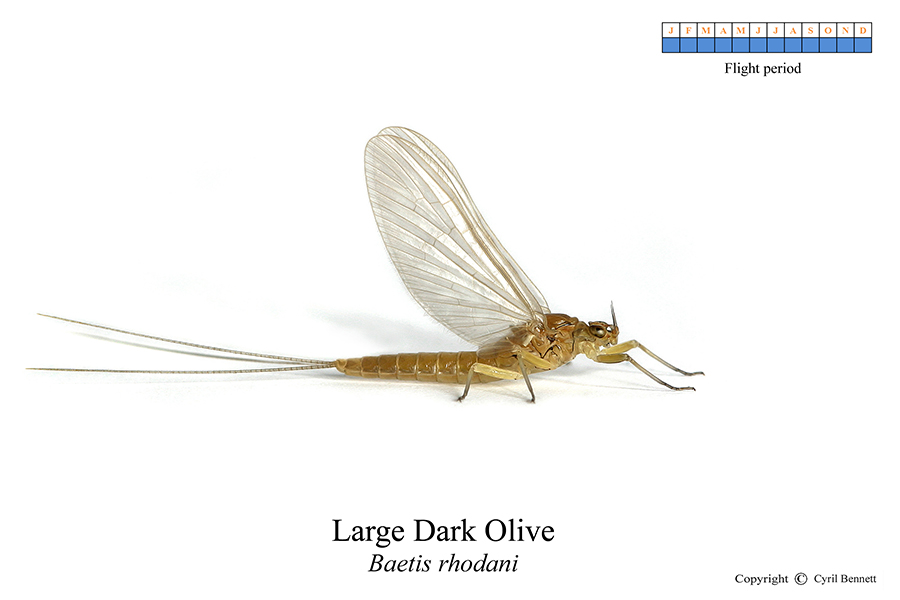- It's been years since I had a break from fly fishing as long as this last one. I was out of action for a shade under three months with a back problem that flares up from time to time. So to get out onto a river again last week was a tonic; never mind that the stream was running wafer thin, or that the sole of one of my wading boots came loose and flapped around like a witches tongue. Never mind either that Robin Douglas and I only rose two small fish between us and missed both of them. I'll take all that anytime, just to feel the silky flow of stream water again. As far as the fishing went the day was not the subject for much discourse, but we consoled ourselves by agreeing to get out again next week. And there has been a little rain in the Cape, so the prospects look promising.

Running wafer thin
Click in images to enlkarge them
Fly tying and studio space
But the time spent nursing my back allowed me to concentrate on a longstanding plan to turn my son Robert's upstairs bedroom into a dedicated art studio and a fly tying den. He moved out some years back to take up a job in London.
The project took longer than planned and cost more than I'd estimated (isn't there an unfailing inevitability in that as far as renovations go?), but the room is now complete. It has perfect north light, newly painted walls, new curtains; in short, with the help of an excellent team of workers and inspiration from my wife, Kathy, and daughter, Alison, the room has now become a bright, fresh and inviting place to tie flies, do my art and relax.

A bright, fresh and inviting place to tie flies, paint and relax.
What's more, the move forced me to sort through my widely scattered assortment fly tying materials, something I've never sat down and done methodically. They are now stored in clearly marked drawers, which makes finding exactly what I need a walk in the park. I also managed to get rid of a heap of stuff I knew I'd never use and, happily, I found welcome homes for all of it.
My fly tying cabinet sits in the centre of a wide desk, flanked by a selection of fly tying and reference books and two small plastic filing cabinets. I have my art table on the opposite wall and on a third wall, a wooden chest of drawers to store the heap of assorted art paraphernalia I have steadily accumulated. Such space and comfort I haven't known in years.

The fly tying cabinet flanked by books and plastic filing cabinets with six, labelled drawers (Bantex Texo). The overhead lamp is on an extension cable and can be pulled down to sit right above the vice.

JVice in place and cabinet doors open. Note, all drawers are still within easy reach.
For those interested (fly tyers will be, the rest can skip it), the wooden cabinet's drawers are labelled from the top left as follows:
Chenilles & Wools, Tinsels, Poly Yarn, Wings & Posts, Rubber Legs & Synthetic Ribbings, Wire & Lead, Cul de Canard feathers, Partridge & Guinea Fowl, General Dubbing, Klipspringer & Water Mongoose, Deer Hair & Tails, Premium Capes.
The black cabinet is labelled from the top down respectively; Dry fly hooks, Emerger hooks, Nymph & Wet fly hooks, Streamer hooks, Coq de Leon Hackle and finally, Foams. The red cabinet is marked from the top down; Hen & Indian Capes, Special hackles, Exotic Feathers, peacock herl & Pheasant tails, Miscellaneous and finally, Marabou. And the small set of mini drawers on top of the black filing cabinet holds my beads.

Alongside the main cabinet hangs one of my most prized possessions, a photograph presented to me by the late John Beams. He's sitting at his fly tying desk and his inscription on the photograph (in now fading ink), says, 'To my guide, philosopher and friend. From John.'

The art desk with lovely north light. Note the beautifully made slant tank for photographing flies from below. It's on the table on the far top left and was made for me by Steve Boshoff.

The chest of drawers with a bronze of a rising trout, another prized possession, given to me by sculptor, Alan Meyburgh.
ScientificFly brings out a new range of Grip hooks
Arno Laubscher, CEO of ScientificFly, says his latest Grip hook models, the 13113BL, 12723BL, 12413BL and 14122BL, are aimed at competitive anglers, have heavier wire, wider gapes and longer curved points.

13113BL

12723BL

12413BL

14122BL
You can visit their website www.scientificfly.com where all the hooks are listed.
Fly fisher's lunch
Our regular biannual fly-fishing lunch was held in Stellenbosch on the Webersburg wine estate, a place new to me.

From left to right Ed Herbst, Pat Garratt, Piet Beyers, Riaan Heyns, Duncan Brown, Robin Douglas, self and a new member invited by Ed Herbst, Marcel Terblanche.
Sadly, Sharland Urquhart could not make the event, but she sent her apologies along with two bottles of 19 year old Webersburg wine, a 1997 Cabernet Sauvignon no less!
I reflected later on the range of subjects we covered over a long, seemingly timeless lunch and was surprised that so little of our riveting ramblings were actually about fly fishing or fly tying, natural enough I suppose, given the challenging and frequently absurd times we live in. But we certainly did find occasion to discuss some fly-fishing books, angling writers and good angling literature, and here's a shortlist of those that featured.
Christopher Camuto: Fly Fisherman's Blue Ridge, a book about fly fishing the backcountry mountain streams in Pennsylvania. Camuto has been the book review columnist for Gray's Sporting Journal for some time.
James Babb: River Music: A Fly Fisher's Four Seasons, the sequel to his book Crosscurrents, hailed as one of the best fly-fishing books of the decade.
Ted Leeson: The Habit of Rivers: Reflections On Trout Streams and Fly Fishing. Originally published in 1994, this book was a fly-fishing phenomenon in the way Howell Raines’s Fly Fishing Through the Midlife Crisis was.
Nick Lyons: In Praise of Wild Trout an anthology that includes writers with the credentials of people like Christopher Camuto and Datus Proper.
Harry Middleton (quite a few titles here!): The Earth Is Enough; On the Spine of Time; Streams and Trout; In That Sweet Country; Rivers of Memory and the most collectable of all, Starlight Creek Angling Society. Only 30 copies exist and my friend Clem Booth owns one of them. And he also owns the bamboo rod Harry Middleton was having built by George Maurer before he, then Maurer himself, died.
Quote of the month

And speaking of Camuto's writing, here's a quote from In Praise of Wild Trout. If I could write like this I'd feel truly blessed.
'I think of trout as an affair of landscape – not something in it, but something of it. In Chinese, the term for landscape, shan shui, means literally "mountains of water." Roughly speaking, if you rub a mountain with cold, flowing water, you get a trout. This is to take a compressed view of geology and evolution, but mythic and scientific ways of thinking about things converge in extraordinary expressions of being, like trout."
From Hugh Rosen in La Jolla California
Hugh says:
I wanted to share with you some wonderful new gear with a software tool for the relief of ennui in the Armchair Angler. The images below of the trophy wild rainbow and brown trout can now be acquired without the inconvenience of the 450 mile drive from San Diego to the High Sierras, or the braving of inclement El Nino winter weather, nor the hit and miss of many hours on-stream looking for suitable fish to target with little nymphs.
Neither rain nor runoff impacting on water clarity have any material impact. I have acquired a selection of two dozen lifelike 3-D polymer trophy trout with articulated jaws from the outstanding trout conservation non-profit www.allfishermanareliars.org. They cover many different species from rainbow, brown, golden, cutthroat, Lahontan cutthroat, steelhead , sea-trout, and various salmon species from Atlantic to Coho. Marble trout and huchen are available by special order. For the maintenance of a credible on-line presence, I use a randomization schedule that reflects the prevalence of rainbow, brown, cutthroat or brook trout in the appropriate river.

Owens River rainbow

East Walker brownie
The photograph is then prepared by dressing in full fishing regalia and posing with the polymer fish spritzed with water on a green screen background. State of the art CGI is then used to superimpose the image on a river background. Allfishermanareliars.org provide comprehensive software support with a library of high-resolution images covering the best pools in Blue Ribbon trout streams of the world, whether you would like to present the catching of an Owens River rainbow, or an East Walker brownie as shown, or locations more exotic. The software and models are restricted at the moment to salmonids and chars, and thus do not help the saltwater angler. One can only hope, that with time, the range will be extended to promote this very important conservation approach.
Thank you Hugh for bringing this useful scientific advancement to our attention. May I suggest that the software will soon develop to the point where you can also select the rod you have in your hand, say a bamboo by Edward Barder, or a Payne, or a Paul Young, or a Nick Taransky, whatever. (Hugh, by the way when he's not fly fishing is a Professor of Medical Science at the Scripps Research Institute in California.) TS.
Strange company on the river
Clem Booth writes:
Interesting day on the Loddon)! I'm minding my own business fishing one of my favourite pools when suddenly there is an almighty commotion on the far bank at which point a deer falls in!

The water is deep and fast flowing so thoughts of plunging in to save it soon abate. Instead I made like a sheepdog and chased it upstream where it was able to find some shallower water and escape. That was a first! I had to evade a snake a couple of times on Cape streams, but never a deer!
Couple of nice fish completed a most interesting day. never a dull moment on the water it seems!

(The Loddon is a chalkstream outside London that Clem fishes regularly. TS.)
Will the real Kite's Imperial please come forward...

I have just posted a piece on tying the Kite's Imperial dry fly. My research pointed to some doubt as to how the original was actually dressed. I think I have solved it.

Ephemera rhodani. Image per kind approval of Dr Cyril Bennett MBE.
The pattern was invented by the late Oliver Kite to imitate the mayfly, Ephemera rhodani, found all year round on the chalkstreams of England and had an under-thorax of purple thread and a wing case of heron herl, doubled and re-doubled in the Netheravon style.

Kite's Imperial
Image of the month

Tom Lewin on the Lourens River above Somerset West. Picture Tom Sutcliffe.
Tom Sutcliffe



